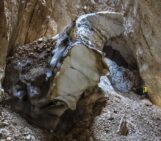
Next time you’re outdoors, in a park or anywhere where there is no pavement, look down at the patch of earth beneath your feet. To many people, it’s just mud, dirt, or maybe soil, something passive that things grow in. But to a soil scientist, that handful of soil represents a dynamic ecosystem that supports an incredible 95% of all the food we eat, filters every drop of our drinking water, and silently locks away more carbon than all the world’s forests and the atmosphere combined.
Right now, this vital, non-renewable resource is facing a full-blown crisis. UNESCO, the United Nations Educational, Scientific and Cultural Organization, is leading the charge on this issue and drawing attention to alarming data: according to reports like the World Atlas of Desertification, an estimated 75% of our soils are already degraded, directly impacting the livelihoods of billions of people. If current trends continue without a coordinated intervention, up to 90% of the planet’s land surface could be degraded by 2050. This is not merely an environmental setback; it’s a catastrophic threat that endangers global food security, accelerates climate change, and impacts the health and stability of entire nations.
Against this terrifying backdrop, a landmark idea emerged from an international conference held in Agadir, Morocco, in 2024: the creation of a World Soil Health Index (WSHI). This isn’t just another scientific paper or a feel-good political declaration; it is a proposed global measuring stick designed to transform our collective ignorance about soil, into targeted, effective action. Think of the World Soil Health Index as the planet’s equivalent of a universal medical scorecard or a global vital signs monitor for the land. Its value is profound, moving the status of soil from a fragmented, local concern to a unified, quantifiable, and undeniable global priority.
The core problem: A crisis that is invisible and unquantifiable
The central obstacle to fixing the global soil crisis is that we currently lack a common language to describe it. For decades, soil management has been based on fragmented, localized data. A soil scientist in the American Midwest measures Soil Organic Carbon (SOC) using different methodologies than a researcher in sub-Saharan Africa. One European region might focus on calculating erosion rates, while a nearby country focuses on microbial diversity within its national parks. This lack of a standardised, universal metric has created a void in global environmental governance.
The inability to consistently measure soil health means this crisis is currently ignored in major international policy and funding decisions, allowing degradation to continue because it remains an invisible and difficult-to-compare global problem. The World Soil Health Index aims to solve this by unifying patchwork data into a single, easily understood, standardised score, derived from a small set of key indicators (such as organic carbon concentration, water infiltration rate, nutrient balance, and microbial activity) which cover the essential physical, chemical, and biological dimensions of soil. Beyond just the scientific benefits, this Index will also enable journalists to report facts clearly, empower politicians to set measurable targets, and hold international signatories accountable, thus elevating soil health to a non-negotiable geopolitical asset.
The value proposition I: Securing the climate foundation
When we discuss slowing down climate change, public attention is almost always fixed on the atmosphere. We think of reducing smokestack emissions or deploying massive, expensive carbon capture technology. Yet, one of the most powerful, cost-effective, and low-tech solutions already exists beneath our feet, waiting to be mobilized!
Soil is, quite simply, the largest terrestrial carbon sink on Earth. Scientific data shows that the top meter of soil holds an astonishing 2,822 gigatons of carbon, which is roughly three times more than the carbon currently stored in the entire atmosphere and four times more than all living plants. The health of our soil dictates whether it acts as a sink, actively pulling carbon dioxide out of the air through plants and storing it, or a catastrophic source, releasing stored carbon back into the atmosphere through degradation. The carbon risk is immense: current rates of soil depletion risk releasing an estimated 4.81 billion metric tons of CO2 per year, a volume equivalent to the annual emissions of major industrial nations.
At this point, you may be asking: “But what about sustainable farming practices?” Well, let me give you a quick overview. Let’s take practices like regenerative agriculture. This is a sophisticated suite of sustainable farming techniques that employs core principles like zero-tillage methods (disturbing the soil as little as possible), the use of cover crops (planting non-cash crops to protect the soil), and diverse crop rotations. The collective function of these practices is to enhance soil structure and biological activity, which allows them to draw atmospheric carbon down and store it more effectively within the soil ecosystem. This process of Measurement, Reporting, and Verification (MRV) has long been the primary obstacle to scaling up soil carbon markets. Investors, corporations, and governments are not motivated to pay for soil carbon credits if they cannot be certain that the carbon is actually staying put in the soil over the long term.
The value proposition II: Ensuring food security and climate resilience
The soil crisis is undoubtedly a direct threat to global food security. As land loses its fertility and structure due to unsustainable practices, it loses its ability to function optimally.
The planetary sponge and adaptation strategy
A healthy soil structure, rich in organic matter, behaves like a giant, super-efficient sponge. It can absorb massive amounts of water during intense rainfall events, which prevents destructive surface runoff and floods. It then holds onto this water and releases it slowly to crops during extended dry periods and droughts (fascinating, right?) Degraded, compacted soil, on the other hand, acts more like a pavement surface. Water runs off almost immediately, causing severe erosion and localized flooding, while leaving fields bone-dry and unproductive during periods of low rainfall. This cycle of degradation is a huge threat to global food security, especially in regions that are already struggling with water scarcity, where land degradation is predicted to reduce global crop yields by about 10% by 2050.
The World Soil Health Index’s physical indicators, such as water infiltration rate, aggregate stability, and bulk density, become vital tools for climate adaptation. The index gives governments a doomsday map to pinpoint which land is about to fail due to flooding or drought. Instead of waiting for a disaster, they use the low scores as an arrow to proactively funnel cash into practices like cover crops and no-till farming in high-risk zones.
The value proposition III: Guiding rational policy and investment
Perhaps the greatest, yet least-discussed, value of the World Soil Health Index is its ability to rationalize political decision-making and ensure the efficient allocation of international funding.
Soil degradation is a global problem, but the severity and causes vary widely. The worst hotspots, usually in arid and semi-arid regions, demand immediate, coordinated international attention. Right now, international bodies and national governments frequently allocate environmental funding based on political momentum, broad geographic targets, or simply lobbying power. The World Soil Health Index, because it is based on hard, scientific data, would allow for transparent, results-based funding.
Imagine the European Union, the World Bank, or a major regional development fund allocating aid based on a simple, verifiable principle: “Funding and specialist expertise will be immediately directed toward nations below the World Soil Health Index threshold. We will also introduce significantly higher incentive payments tied directly to every point of measurable improvement they achieve in their score within the agreed period.” (That’s how it should be, right?) This approach would transform policy from simply providing broad aid to rewarding measurable ecological performance. It would introduce a desperately needed element of verifiable success, accountability, and long-term commitment into large-scale conservation efforts, aligning the index directly with key UN Sustainable Development Goals.
On making the invisible indispensable
The World Soil Health Index is a declaration that humanity is finally recognising the non-negotiable value of the soil beneath our feet. This proactive response, championed by UNESCO and the global scientific community, provides the much-needed Monitoring, Reporting, and Verification for climate finance, the resilience data required for climate adaptation, and the universal language necessary to coordinate a planetary-scale response. So when we score soil, we finally give it an undeniable, measurable voice in global politics, which allows us to finally stop shovelling in the dark and start investing in this most valuable asset, proving that the key to a sustainable future is found in the handful of living dirt we stand upon.




